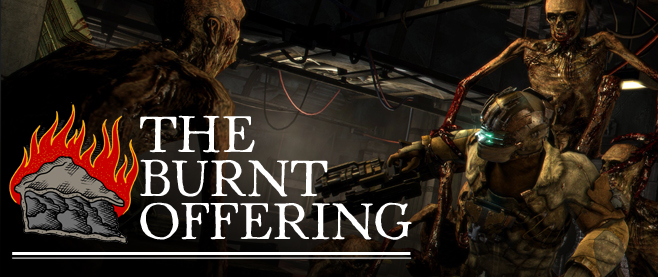Beginnings in the Dead Space Trilogy
Dead Space
To open a sci-fi horror story with a suicide note is bold, and even bolder to disguise it as a love letter. “How else,” the writers behind Dead Space must have asked each other, “can we introduce an industrial future space station plagued by zombies, beset by religious fanatics and explored by a silent engineer with hallucinogenic dementia?” The panicked recording by Nicole, leading man Isaac’s space girlfriend, sets up part one of the impetus. Isaac is on a mission – a mission of love.
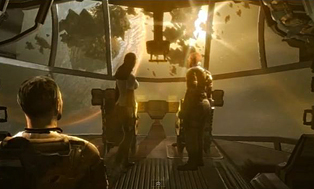 And horror needs such a mission, because without it, what would come crashing down? Dead Space, however, doesn’t just rest on reuniting lovers; Isaac’s an engineer, and he’s got a ship to fix. And as the game opens to the star-washed yellow of a spaceship’s viewport, the ship in question peeks out from behind errant space debris. “The USG Ishimura,” Officer Hammond reminds Isaac. Then some spiel about precious minerals, planet-cracking, communications, fixing encoders, a garbled radio signal, some tense disagreement with the crew and a crash landing in the darkened ship’s docking bay.
And horror needs such a mission, because without it, what would come crashing down? Dead Space, however, doesn’t just rest on reuniting lovers; Isaac’s an engineer, and he’s got a ship to fix. And as the game opens to the star-washed yellow of a spaceship’s viewport, the ship in question peeks out from behind errant space debris. “The USG Ishimura,” Officer Hammond reminds Isaac. Then some spiel about precious minerals, planet-cracking, communications, fixing encoders, a garbled radio signal, some tense disagreement with the crew and a crash landing in the darkened ship’s docking bay.
Isaac now has three motives: Find the girl, find the crew and fix the ship. The last, arguably the most important, catalyst waits in the vents just two rooms away.
Once Isaac’s party recovers from the crash, I’m given control. The only instructions accompanying my control are walking and running. I have no weapons and, presently, no need for them. Assessing the damage, Hammond and crew abandon the totaled vessel and head deeper into the ship, past an antechamber to a lobby littered with luggage. The power is out, the room lit by sickly yellow emergency lighting. The floors, walls and chairs are all brown. My new objective is to check the floating blue monitor in the adjacent windowed room.
A digital model of the ship flashes red with warning signs and the lights suddenly shut off, replaced by a spinning white floodlight that blinds me on each pass. The monitor blinks the word “QUARANTINE” and Hammond tries to reassure the others. “What was that? Did you hear that?” Through the window I can see a disfigured creature drop from a vent and stalk a nearby guard. “Something’s in the room with us.” The creature pounces, slashing blood onto my window and obscuring my view as the others open fire.
“Isaac, the door’s unlocked. Run.” The sound of more vents popping loose urges me towards the illuminated doorway. I notice a frantic, discordant string section fading in, heightening the panic. I’m still without any means of defense, my only learned abilities walking and running. I pour awkwardly through the opening into a narrow hallway where a creature plunges on the ground directly behind me, causing me to stumble forward and slowing my escape. I can’t see behind me or much on either side; the camera is pulled in close over my shoulders. I narrowly dodge another leaping creature. The lights flicker and the strings crescendo.
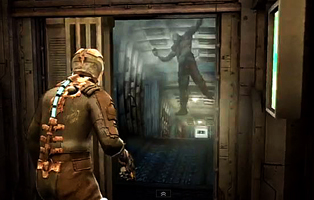 At the end of the twisting corridor, I lurch into an elevator and turn around to close the door. I have just enough time to see the creatures barreling towards me in the hall. The elevator doors shut and the strings quiet, the chase over. But what’s horror without a little surprise? The door bursts open, forced apart by the mangled blade-arms on the creature, it’s maw spewing and snarling at me. The sound, according to the developers at Visceral Games, is a combination of (at least) a lion’s roar, an elephant’s cry, and a human’s scream. The strings attack again, and the creature jumps to strike just as the door pinches shut, severing its head and arms. I can kick them around on the elevator floor – with physics! The strings subside again.
At the end of the twisting corridor, I lurch into an elevator and turn around to close the door. I have just enough time to see the creatures barreling towards me in the hall. The elevator doors shut and the strings quiet, the chase over. But what’s horror without a little surprise? The door bursts open, forced apart by the mangled blade-arms on the creature, it’s maw spewing and snarling at me. The sound, according to the developers at Visceral Games, is a combination of (at least) a lion’s roar, an elephant’s cry, and a human’s scream. The strings attack again, and the creature jumps to strike just as the door pinches shut, severing its head and arms. I can kick them around on the elevator floor – with physics! The strings subside again.
In the instant when Isaac is issued the command “Run,” the motive to survive supersedes. Now, it’s not the only instinct at play; if it were, then Dead Space would be a quick cower-in-the-elevator-simulator. The narrative arcs involving Nicole and uncovering the mystery of the crew are still relevant motives, and the objective to fix the ship has now melded with survival to create the “get the hell outta there” motive. Given the grounding sci-fi elements of the marker (zombie-making rock) and the space travel, Isaac’s new objectives logically follow and remain consistent until the last chapter. Even when Isaac accrues his engineer’s arsenal and discovers what transpired and the mysteries start to unravel at the end, the survival impetus persists.
———
Dead Space 2
The sequel wastes little time in getting to the debilitating powerlessness that marks interactive survival horror. As a means of homage or parallel framing, it opens with a short, choppy transmission from Nicole, this time in-conversation with the now-voiced Isaac. With a twist of irony, she thanks him for pushing her onto the USG Ishimura, the ship where she would die and where he would contract marker-induced dementia. And in a twist on THAT twist (meta-twistah), the video is a dementia-induced hallucination during a psych exam.
 Then another hallucination, neatly recapping the events from Dead Space, stars possessed-Nicole-with-glowing-faceholes. She screeches, “Make. Us. Whoooooooole.” And then boom, Isaac wakes up from his third-level inception dream sequence to Franco, a panicked ally, bringing him out of his stupor. The room is dark, the camera is close and over-the-shoulder, almost like during gameplay but even closer. Unlike its predecessor, Dead Space 2 uses Isaac’s face and voice. He’s disoriented and weak, his life-indicating RIG glowing yellow, and, oh, yes, he’s in a straitjacket. The lens flare from Franco’s flash light further disorients.
Then another hallucination, neatly recapping the events from Dead Space, stars possessed-Nicole-with-glowing-faceholes. She screeches, “Make. Us. Whoooooooole.” And then boom, Isaac wakes up from his third-level inception dream sequence to Franco, a panicked ally, bringing him out of his stupor. The room is dark, the camera is close and over-the-shoulder, almost like during gameplay but even closer. Unlike its predecessor, Dead Space 2 uses Isaac’s face and voice. He’s disoriented and weak, his life-indicating RIG glowing yellow, and, oh, yes, he’s in a straitjacket. The lens flare from Franco’s flash light further disorients.
“Listen, you’re in terrible, terrible dan-,” Franco ekes out before a familiar brown blade pierces his chest. The winged necromorph mounts his shoulders to plunge a tendril into Franco’s forehead, still inches away from Isaac’s face and the claustrophile cameraman. In what has been described as a pain-staking, laborious animation to create, Franco’s body transforms rapidly, violently to the camera. Sharp appendages jut from his shoulders, short tentacles protrude from his nose and mouth, then a shock rips up his neck and face, tearing the fleshy mess open and forcing it almost onto Isaac’s face. A headbutt and Isaac is free, the camera settling into its perch over the shoulder, control now passed to me. A single word commands: “Run.”
How wonderful, really! Interactive horror at its basest! Sure, the bit about marker still lurks behind the curtain, but the only active motivation is survival, and the only tool to accomplish it is movement. As Necromorphs come screaming through glass-paned exam rooms lining the halls, skittering across the floor ahead and barreling into slicing doorways, all I can do is run. I’m debilitated and terrified, my control in as much a straitjacket as Isaac. Huzzah, huzzah!
 Now, this moment isn’t original to this series and might go by quickly enough to escape notice if the better part of the first chapter weren’t still spent in that straitjacket. The immediate panic to escape is gone, replaced with the slower burn of forward-moving survival, also known as the “DON’T GO IN THERE!” effect. But I have to walk under the vents that just swallowed two gun-toting goons if I want to get out of this jacket and gain some defensive tools. I have to cross the blood-covered medical labs to find the lunatic with the scalpel. I have to let him free me, then pick up the flashlight, then watch him carve a deep gash across his own neck. I have to navigate the pitch, pitch-dark assembly room, no safer than before. I have to crawl into a vent where I know, I just know they’re crawling.
Now, this moment isn’t original to this series and might go by quickly enough to escape notice if the better part of the first chapter weren’t still spent in that straitjacket. The immediate panic to escape is gone, replaced with the slower burn of forward-moving survival, also known as the “DON’T GO IN THERE!” effect. But I have to walk under the vents that just swallowed two gun-toting goons if I want to get out of this jacket and gain some defensive tools. I have to cross the blood-covered medical labs to find the lunatic with the scalpel. I have to let him free me, then pick up the flashlight, then watch him carve a deep gash across his own neck. I have to navigate the pitch, pitch-dark assembly room, no safer than before. I have to crawl into a vent where I know, I just know they’re crawling.
It’s not until I’ve run this gauntlet-du-Amnesia that I find a means of offense, the kinesis module, which depends on objects in the environment to use as projectiles. Even then, I’m still two rooms away from a proper weapon, a repurposed surgical laser. Another eye-opening segment aside, the remainder of Dead Space 2 runs on hallucinogenic fumes about markers, a religion and plenty of well-built action segments. The fast, frantic horror in the straitjacket’s embrace sounds a distinct, clear echo from the traumatic vision conceived in the original game.
———
Dead Space 3
Murder comes naturally in Dead Space 3. The game opens with a wintry storm, a lone soldier (or two soldiers in coop) emerging from the snowy mist and lowering his helmet. The broken transmission communicates a sense of urgency, but the reason is unclear. In the blanket of white grain on a white landscape, the camera pulls over the shoulder, this time a little further out. With the few extra degrees in the peripheral, the environment takes on more weight. The instructions say to follow the blue line. I walk the line for a few seconds and emerge from the blinding snowstorm onto a cliff side. A detailed ice station sits below, and a crashed spaceship hangs on a nearby ridge.
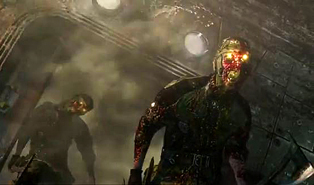 I notice that I have a gun, and discover there’s no ammo. Ok, things are heating up for ol’ soldier boy. Another derelict vessel, another defenseless rogue? The fear is starting to spread.
I notice that I have a gun, and discover there’s no ammo. Ok, things are heating up for ol’ soldier boy. Another derelict vessel, another defenseless rogue? The fear is starting to spread.
I approach the vessel cautiously, the empty weapon aiming left, then right. Green and yellow boxes are scattered across the ground. Still on edge, I stomp them open. WAIT. What was that? Ah, packs of ammo. I’m armed now. Hmm.
I shoot open the door to the spaceship, and the discordant strings strike back. It’s, it’s… a dead guy and two axe-wielding, yellow-eyed murderers. I do have a gun, though, so I shoot them, and they die. I venture further into the ship – more murderers, more shooting, more death. Some jump out. Boo! I make it to the bridge, grab the objective, and – oh no, avalanche! Good thing I brought this rappelling grapple, so I can shoot down this cliff face while the mountain crumbles around me. I reach the base camp, now littered with dead bodies, some on poles. The general shoots me, destroys the objective, then shoots himself.
Two hundred years later, the real story picks up in Isaac’s apartment on the Lunar Colony. Here we go, back to old reliable. He’s been drinking (psychologically impaired, love it) and thinking about his girlfriend (familiar, on-board), and looking at old, chopped-up pictures (angsty, sure). He claws some paper off a desk in an apparent post-breakup rage. His health, indicated by a full, blue RIG, is stellar. The door opens. Isaac jumps, grabs a gun. He’s floored by a red-eyed soldier. He… um… well, he talks back to the guy, while at gunpoint. Curious.
I’m immediately given context. Isaac’s girlfriend got lost on a suicide mission to destroy a marker, and this group of government soldiers wants my participation in a rescue mission. If I know Isaac, though, there’s no way he’d be caught dead going into the hornet’s nest, especially if the hornets are violent, mutated life forms. Yeah, he even says it’s a suicide mission. You’ll never take me alive, coppers!
Well, that’s what Isaac could have said, I guess. Instead, the conversation is interrupted by a distant explosion seen through a window. It lends the meeting some urgency, but no panic. No big, y’all, just some religious fanatics destroying a moon colony. Resume chatting.
“Okay. Okay!” Wait, that’s it? Dive into another nightmare zombie attack scenario, after having been in two already? For your ex-girlfriend? I can’t claim to understand Isaac’s motives here, but I’m willing to play along. Hey, there’s even some intrigue with these Unitologist terrorists that I’ve only begun to grapple with, so there’s hope.
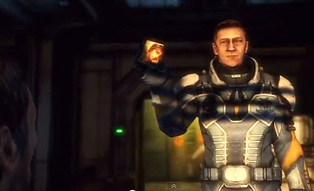 The red-eyed soldier gives Isaac a gun. At this point, it’s what I’m expecting. I take to the filthy streets of the moon and start popping off rounds at other shooters in cover. The pace picks up the scent of the survival-horror trail later when, naturally, the necromorphs rear their skinless heads. There’s a great little moment where the game teaches me how to stomp a corpse, then tempts me to stomp what looks like a corpse. And it’s all over and into outer space without being disarmed even once.
The red-eyed soldier gives Isaac a gun. At this point, it’s what I’m expecting. I take to the filthy streets of the moon and start popping off rounds at other shooters in cover. The pace picks up the scent of the survival-horror trail later when, naturally, the necromorphs rear their skinless heads. There’s a great little moment where the game teaches me how to stomp a corpse, then tempts me to stomp what looks like a corpse. And it’s all over and into outer space without being disarmed even once.
Clearly, not every game in a series should start the same way. That Dead Space 2 manages to pull off almost the same tricks as the introduction in Dead Space is nothing short of inspired, and it sets a terrifying precedent for just how the far the game is willing to go to make me squirm. The surprise tentacle segments are replaced by surprise freefalling train segments, and the formula for horror works its goodness again. Dead Space 2 even goes back to the same ship, the same rooms as Dead Space to recapture some of the screams.
Dead Space 3, for all its tension, jump scares and severed heads carves a meaningfully separate path in the pursuit of horror, one driven by seamless set design and empowerment. The sound design and combat design reach an all-time high in quality and efficiency as Isaac plunges himself into the mystery of the markers. First impressions, though, imply demands. If Dead Space is my first impression of Dead Space 3, then I demand to survive.




